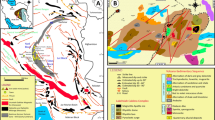Abstract
The Peuyuk kimberlite is divisable into three petrographically distinct phases (A, B, and C) on the basis of oxide mineralogy and the presence or absence of an immiscible carbonate liquid.
Phase A contains spinels (titan-magnesian-aluminous chromite) and perovskite with no reaction rims or complex mantles, and no evidence of an immiscible carbonate liquid.
Phase B contains complexly zoned and mantled oxides with no evidence of an immiscible carbonate liquid. The spinels are zoned from titan-magnesian-aluminous chromite to members of the magnesian ulvospinel-ulvospinel-magnetite series. The zoned spinels are mantled by a serpentine-carbonate mixture followed by a mixture of Ti free magnetite and minor rutile. Perovskites are mantled by nickeliferous pyrite (0–11 % Ni) and rutile.
Phase C is characterized by the presence of an immiscible carbonate liquid. Spinels are either discrete crystals of magnesian ulvospinel-ulvospinel-magnetite or as discrete rims of this composition upon cores of titan-magnesian-aluminous chromite. Rutile rims are poorly developed upon perovskites. Sulphides associated with the silicate groundmass are Cu-pentlandite, heazle-woodite and chalcopyrite. Nickeliferous pyrite is associated with the carbonate fraction.
Common to all phases of the intrusion is a red titanium poor aluminous-magnesian chromite which is interpreted to have formed prior to the fluidized intrusion of the kimberlite. All other spinels being considered to have crystallized after fluidization.
The spinel composition trends may reflect decreasing oxygen fugacities (10−19 to 10−22 bars) in response to falling temperatures (800–600° C) along the quartz-fayalite-magnetite buffer.
In the immediate post-fluidization history of the diatreme all phases crystallized titan-magnesian-aluminous chromite but the trends of Ti and Fe enrichment observed in phases B and C was prevented in phase A possibly by rapid cooling. Slower cooling coupled with reaction of earlier formed phases with residual H2O and CO2 rich fluids resulted in the phase B assemblage. Extensive reaction of this type was prevented in phase C by the separation of an immiscible carbonate liquid.
Similar content being viewed by others
References
Mitchell, R.H., Fritz, P.: Kimberlite from Somerset Island, District of Franklin, N.W.T. Can. J. Earth Sci. 10, 384–393 (1973)
Mitchell, R.H.: Geology, Magnetic expression and structural control of the central Somerset Island kimberlites. Can. J. Earth Sci. 12, 757–764 (1975)
Clarke, D.B., Mitchell, R.H.: Mineralogy and petrology of the Somerset Island kimberlite, N.W.T., Canada. Phys. Chem. Earth 9, 123–135 (1975)
Rucklidge, J.C.: A computer program for processing microprobe data. J. Geol. 75, 126 (1967)
Haggerty, S.E.: Compositional variations in lunar spinels. Nature Phys. Sci. 233, 156–160 (1971)
Irvine, T.N.: Chromian spinel as a petrogenic indicator. Part I. Theory. Can. J. Earth Sci. 2, 648–672 (1965)
Carmichael, I.S.E.: The iron-titanium oxides of salic volcanic rocks and their associated ferromagnesian silicates. Contrib. Mineral. Petrol. 14, 36–64 (1967)
Haggerty, S.E.: Luna 16: an opaque mineral sutdy and a systematic examination of compositional variations of spinels from Mare Fecunditatis. Earth Planet. Sci. Letters 13, 328–352 (1972)
Arculus, R.J.: Solid solution characteristics of spinels: Pleonaste-chromite-magnetite compositions in some island-arc basalts. Carnegie Inst. Wasch. Yr. Book 73, 322–327 (1974)
Mitchell, R.H.: Compsotion of perovskite in kimberlite. Am. Mineralogist 57, 1748–1753 (1972)
Haggerty, S.E.: The chemistry and genesis of opaque minerals in kimberlite. Phys. Chem. Earth 9, 295–307 (1975)
Mitchell, R.H.: Magnesian ilmenite and its role in kimberlite petrogenesis. J. Geol. 81, 301–311 (1973)
Heinrich, E.W.: The geology of carbonatites. Rand McNally. 555 pp. (1966)
Anderson, A.T.: Chlorine, sulfur and water in magmas and oceans. Geol. Soc. Am. Bull. 85, 1485–1492 (1974)
Haughton, D.R., Roeder, P.L., Skinner, B., Jr.: Solubility of sulfur in mafic magmas. Econ. Geol. 69, 451–462 (1974)
Haggerty, S.E.: Spinels of unique composition associated with ilmenite reactions in the Liqobong kimberlite pipe, Lesotho. In: Lesotho Kimberlites. P.H. Noxon, Ed., pp. 149–158, Lesotho National Development Corp. Maseru (1973)
Dawson, J.B., Hawthorne, J.B.: Magmatic sedimentation and carbonatitic differentiation in kimberlite sills at Benfontein, South Africa. Quart. J. Geol. Soc. London 129, 61–85 (1973)
Emeleus, C.H., Andrews, J.R.: Mineralogy and petrology of kimberlite dike and sheet intrusions and included peridotite xenoliths from South West Greenland. Phys. Chem. Earth 9, 179–197 (1975)
Evans, B.W., Moore, J.G.: Mineralogy as a function of depth in the prehistoric Makaopuhi tholeiitic lava lake, Hawaii. Contrib. Mineral. Petrol. 17, 85–115 (1968)
Thompson, R.N.: Titian chromite and chromian titanomagnetite from a Snake River Plain basalt, a terrestrial analogue to lunar spinels. Am. Mineralogist 58, 826–830 (1973)
Gunn, B.M., Coy-yill, R., Watkins, N.D., Abranson, C.E., Nougier, J.: Geochemistry of an oceanite-ankaramite-basalt suite from East Island, Crozet Archipelago. Contrib. Mineral. Petrol. 28, 319–339 (1970)
Cameron, E.N., Glover, E.D.: Unusual titanian-chromian spinels from the Eastern Bushveld complex. Am. Mineralogist 58, 172–188 (1973)
Arculus, R.H., Gillberg, M.E., Osborn, E.F.: The system MgO-iron oxide-Cr2O3-SiO2: Phase relationships among olivine, pyroxene, silica and spinel in air at 1 atm. Carnegie Inst. Wash. Yr. Book 73, 317–322 (1974)
Muan, A., Hauck, J., Lofall, T.: Equilibrium studies with a bearing on lunar rocks. Proc. 3rd Lunar Sci. Conf. 1, 185–196 (1972)
Nehru, C.E., Prinz, M., Dowty, E., Keil, K.: Spinel group minerals and ilmenite in Apollo 15 rake samples. Am. Mineralogist 59, 1220–1235 (1974)
Muan, A., Hauck, J., Osborn, E.F., Schairer, F.J.: Equilibrium relations among phases occurring in lunar rocks. Proc. 2nd Lunar Sci. Conf. 1, 497–505 (1971)
Nicholls, J., Carmichael, I.S.E., Stormer, J.C., Jr.: Silica activity and P total in igneous rocks. Contrib. Mineral. Petrol. 33, 1–20 (1971)
Mitchell, R.H.: Composition of olivine, silica activity and oxygen fugacity in kimberlites. Lithos 6, 65–81 (1973)
Kullerud, G., Yund, R.A.: The Ni-S system and related minerals. J. Petrol. 3, 126–175 (1962)
Author information
Authors and Affiliations
Rights and permissions
About this article
Cite this article
Mitchell, R.H., Clarke, D.B. Oxide and sulphide mineralogy of the Peuyuk kimberlite, Somerset Island, N.W.T., Canada. Contr. Mineral. and Petrol. 56, 157–172 (1976). https://doi.org/10.1007/BF00399601
Received:
Accepted:
Issue Date:
DOI: https://doi.org/10.1007/BF00399601



